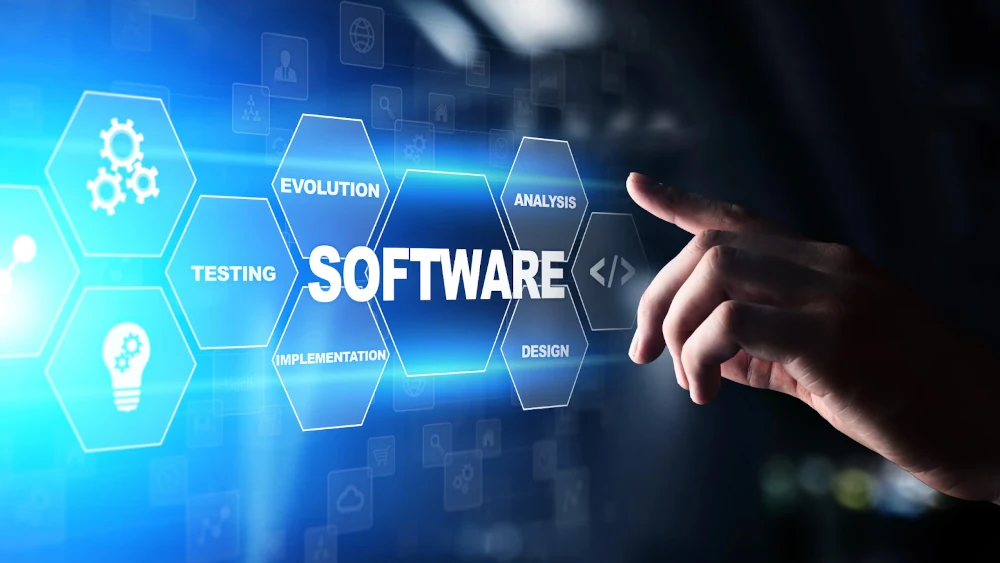Software development managers (SDMs) are at a unique intersection of technology, leadership, and business. By providing technical guidance, training and mentoring developers, managing schedules and ensuring everything comes together at the right time to facilitate everyone’s success, they help engineering teams do a fantastic job of building great things in code. In a world increasingly defined by agile and scrum, SDMs balance the hands‑on technical expertise needed to lead teams with people-focused leadership skills that help companies position their ideas of tomorrow while executing to realize that vision.

Software Development Manager
A Software Development Manager is an organizational mid-to-senior leadership position, ultimately responsible for the planning, execution, delivery, and maintenance of software projects. Though not expected to engage with code like a software engineer, their focus will be more on:
- Direction or focus with the project team
- Strategic planning activities across projects
- Resource allocations and budgeting
- Coaching technical staff, mentoring with a focus on growth
They also serve as points of contact between engineering teams and product leads, as well as business leaders.
Technical Strategy and Architecture
Primary Responsibilities of an SDM
Technical Strategy and Architecture
SDMs are involved in the definition of the technology roadmap. This involves evaluating framework, platform and tooling options for our products and understanding how to check for long-term potential and technical feasibility.
Team Leadership and Mentoring
SDMs are in charge of hiring, onboarding, coaching and promoting engineers. Part of their job is to mentor junior engineers and build a sustainable and awesome growth culture.
Project Management
In order to ensure timely completion, SDM schedules dependencies and/or bottlenecks, and schedules the deadlines and deliverables of the projects.
Interprofessional Collaboration
In order to get the focus on priorities, iterate in the product and adapt according to the market, SDMs need to work closely with Product Managers, Designers, Quality, DevOps and support teams.
Metrics, Quality and Performance Monitoring
SDMs prioritize metrics for Services, such as velocity, quality (bug counts), uptime, and adoption, to allow for measuring team performance and product health.
Risk Management & Mitigation
SDMs should proactively and strategically identify the level of technical or resource-based risk and develop mitigation plans. As necessary, escalate risks to senior management in a timely fashion.
How SDM is Different From Other Roles
The Software Development Manager (SDM) has a unique role in a software engineering team. Here are the high-level roles and responsibilities of many of these roles, with the SDM at the end:
Software Engineer
Writing, testing, and maintaining code. Primarily responsible for building features and components.
Senior Software Engineer
Working on a more complex system. Often mentoring junior developers and contribute to architecture decisions.
Tech Lead (Technical Lead)
Is responsible for being the technical authority on a project. Devotes time to coding but is also responsible for guiding technical direction, code reviews, and several deep technical problems.
Engineering Manager
The leader of a team of developers is not primarily responsible for the delivery, but is more responsible for the people, performance reviews, and process.
Software Development Manager (SDM)

The leader of multiple teams and/ or large-scale engagements. Aligning engineering with product and or business. Involved in less coding and more thinking, strategic planning, hiring and cross-function.
Key Skills for Successful SDMs
Technical Skills
Ability to understand architectural considerations, coding best practices, CI/CD, cloud technologies, and Software Development Lifecycle (SDLC).
Leadership and People Management
Coaching, feedback, performance management, conflict management, guiding future career paths, etc.
Communication and Stakeholder Management
An SDM must have both verbal and written communication skills, especially when meeting with senior leaders, product teams, and external partners.
Strategic Thinking & Roadmapping
From converting business requirements to technical priorities to sprint objectives.
Data-Driven Decision Making
Utilizing metrics (velocity, MTTR, quality indices) to shape prioritization and optimization.
Typical Career Path
- Software Engineer → lays the groundwork for technical, foundational capabilities needed to practice software development.
- Senior Engineer / Tech Lead → Mentors peer engineers in deciding specifications and defining system design.
- Engineering Manager → has ownership over one or two small teams, allowing limited flexibility over delivery scope.
- Software Development Manager → responsible for delivery across multiple teams or one larger team with scope for strategic thinking influence over delivery, culture, analysis, and process.
After SDM development mostly progresses to a Director of Engineering or SVP/VP.
Real-World Example: Day-in-the-Life
A day may consist of:
- Grooming standup sessions with team leads, and slightly coaching them.
- 1-on-1s with engineers that discuss future individual career paths
- Sprint review, design review and architecture
- Roadmap alignment meeting with Product Lead
- Bug triage call after production incident
- Hiring discussions, interview panel sessions, and other sessions on who to hire
- Review of metrics, identifying anything preventing launches
This person transitions between tactical delivering in harmony with the strategic vision, and importantly, the scalability for the future.
Popular Management Frameworks SDMs Use
- Agile (Scrum/Kanban) for iterative delivery
- OKRs (Objectives and Key Results) to get alignment on team goals
- Code ownership and DevOps mindset for systems reliability
- 1:1s frameworks from books like “Radical Candor” for better feedback
Common Challenges and Mitigation Strategies
- Delivery delays & scope creep → Enforce realistic planning, scope clarity, mid-sprint pivots
- Team burnout → optimize workload, adjust priorities, and ensure psychological safety.
- Technical Debt → ensure allocated time for refactoring and debt reduction regularity.
- Talent Management → balance and prioritize growth opportunities, mentorship and retention.
Measuring SDM Impact
Some KPIs SDMs monitor:
- Sprint completion metrics (e.g., % of committed story points delivered)
- Mean Time To Recovery (MTTR) after incidents
- Bug fix velocity and trends in quality
- Employee engagement or NPS survey scores
- Retention rates and promotion cadence
- Productive, motivated, and reliable software teams aligned to business goals typically signify evidence of the SDM’s success.
SDM Role in Different Company Sizes
Startup (1–10 devs)
SDMs can be “Tech Leads” and wear many hats: collaborating on product decisions, architecture, hands-on coding, and interviewing.
Scale-Up (10-50 devs)
There is a shift of focus onto delivery discipline, scale of team structure, developing strong CI/CD pipelines, and much more time spent on people management.
Enterprise (50+ devs)
Less hands-on. Focuses on multiple team alignment, governance and collaboration for teams to accomplish complex projects.
Future of the role
Titles have come and gone for SDMs as they adjust to both Agile and DevOps demands. Some commonly evolving areas include:
- AI-driven management tools with machine learning for code reviews or backlog grooming
- Remote-first leaders – leading remote teams off-site
- Developer experience (DevEx) – paying special consideration to developer tools that reduce friction
- Sustainability and ethical coding as software get woven into everything we touch.
Conclusion
While a Software Development Manager is a hybrid leader grounded in engineering skills but also an informal mentor, a strategic thinker, and a shaper of communication, they’re also responsible for guiding teams to deliver working and quality software within constraints of time/budget, communicating what teams are doing to achieve business goals, and creating an organization of learning and growth. Whether you’re leading a small nimble startup or a larger enterprise organization, SDMs will play an important role in the culture of who they lead and also what they deliver.
An aspiring SDM should develop a pathway and foster technical expertise around their role as an SDM, emotional candor as a professional trait, and organizational sensitivity in relation to the larger organization. For organizations, the return on investment in a great SDM can be enhanced product delivery, higher team satisfaction, improved teams’ capacity to innovate and generally happier employees!
In a world that relies on software now more than ever, Software Development Managers bridge the gap between code and successful businesses.
FAQs
Does an SDM need to have technical depth?
Yes, being technically deep helps build trust with the team and make the right architectural decisions.
Is the SDM a more technical role or a leadership role?
It does both! Smaller teams will lean toward technical, while larger organizations will lean toward leadership.
Can SDM still code?
Yes! Many SDMs spend 10–20% of their time in code reviewing PRs or prototyping a solution.
How many people does an SDM typically manage?
5 to 20 developers are typical. Larger organizations may have SDMs who report to Directors and may have a hierarchy.
What is the biggest challenge for SDMs?
Balancing delivery speed with team well-being and long-range strategic priorities.


